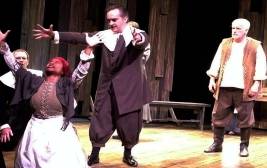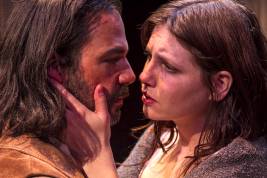RECOMMENDED
When Arthur Miller’s The Crucible was written in 1953, it was considered an allegory for the McCarthy “witch hunts,” Communism taking the place Satan occupied in the original Salem Witch Trials of 1692. Today, as religious fundamentalists of various creeds use blind belief in dogma as a way to persecute those they disagree with, The Crucible stands stronger than ever as an indictment of religious fanaticism gone amok, making this election year a particularly fitting time to revive the Miller classic, one of a number of reasons to check out the production now playing at Hollywood’s Lillian Theatre.
 Though Bill Voorhees seems to have bitten off more than he can chew by undertaking the dual responsibilities of directing and starring in this bear of a play, the resulting production is nonetheless compelling, emotionally wrenching and, even today, shocking in its depiction of ignorance and mass hysteria.
Though Bill Voorhees seems to have bitten off more than he can chew by undertaking the dual responsibilities of directing and starring in this bear of a play, the resulting production is nonetheless compelling, emotionally wrenching and, even today, shocking in its depiction of ignorance and mass hysteria.
The year is 1692. At lights up, we are in a bedroom in the home of Reverend Samuel Parris (Trevor H. Olsen), a man living in fear that his “many enemies” will drive him from his pulpit. His daughter Betty (Grace Kaufman) has returned from a night in the woods and now lies in bed, nearly comatose. Parris soon learns that Betty and some other local girls were committing the sin of dancing in the forest, and perhaps worse.
 The girls’ apparent leader, concupiscent Abigail Williams (Jessicah Newfeld), asserts that “there be no blush about my name,” yet eight months ago she was dismissed from her job at the home of John and Elizabeth Proctor (Voorhees and Lauren Dobbins Webb) following Elizabeth’s discovery of John and Abby’s clandestine affair.
The girls’ apparent leader, concupiscent Abigail Williams (Jessicah Newfeld), asserts that “there be no blush about my name,” yet eight months ago she was dismissed from her job at the home of John and Elizabeth Proctor (Voorhees and Lauren Dobbins Webb) following Elizabeth’s discovery of John and Abby’s clandestine affair.
Meanwhile, Mrs. Ann Putnam (Lorianne Hill) has begun to suspect elderly midwife Rebecca Nurse (Lynn Odell) of being of being an agent of Satan and the cause of her string of seven miscarriages. Mrs. Putnam’s husband Thomas (Brad Light) advises Reverend Parris to “strike out against the devil, and the town will bless you for it.”
The best defense against his waning popularity being a good offence, Parris decides to take this advice. He is aided and abetted by Abigail who, having seen her parents killed by Indians, fears nothing but the loss of her lover, John Proctor, and if accusing Elizabeth of witchcraft is the only way to get back into John’s bed, then accuse she will.
Though Rebecca warns that “there is prodigious danger in the seeking of loose spirits,” Parris goes ahead and summons Reverend John Hale (Anthony Backman), an authority on witchcraft, and the hunt is on. “The town’s gone wild,” declares a fearful Elizabeth, predicting rightly that the accused “will hang for witchcraft.”
Only Elizabeth and John seem to understand that this so-called witchcraft is a fraud, but who will believe them? “The girl’s a saint now,” says John of Abigail, and anyone who dares to doubt her is sure to be her next victim.
It is at this point that the parallels between the Salem Witch Trials and the McCarthy Witch Hunt are the strongest, the best way to be exonerated being to point one’s finger at others, no matter how innocent they may be. Yet none of this would be happening were religious leaders and judges using their heads rather than blindly accusing anyone who doubts the veracity of Abigail’s accusations of being in league with the devil. (The mere reading of books, i.e. seeking knowledge, is considered a sign of Satan.)
Though Reverend Hale is sharp enough to eventually realize the truth, by then it is too late, for the judges in charge of the trials, particularly Deputy-Governor Danforth (David Ross Paterson), refuse to stop the proceedings because this would mean admitting having been wrong from the start. (One cannot help but compare this to the Bush administration’s stubborn refusal to pull out of Iraq, and Abigail and the other accusers’ “power trip” is reminiscent of Kenneth Starr’s during the Clinton impeachment hearings.)
Arthur Miller’s brilliance as a playwright has never been more evident than in The Crucible, for despite the stilted 1692 English, the historical characters which the play depicts are as contemporary as those in his modern dramas (Death of a Salesman, All My Sons, etc.) and as compelling. Despite knowing the play’s outcome, the audience cannot help hoping that somehow, someone in power will see the girls’ “pretense,” and end this murderous witch hunt.
At the heart of The Crucible is the story of a love reborn in times of fear and danger. John Proctor turned to Abigail because, as Elizabeth now realizes, “I counted myself so plain, so poorly made, no honest love could come to me. It were a cold house I kept.” Though the opposite of “plain” or “poorly made,” the lovely and talented Webb gives a moving, subtly understated performance as a wife betrayed. Opposite her, Voorhees makes for a rough-hewn, smolderingly attractive John, a man easily capable of inspiring Abby’s lust, and his final scene with Webb is as gut-wrenching as it gets. Still, a more modulated performance (and greater familiarity with his lines) would make Voorhees’ performance more a more all-around successful one.
As director, Voorhees uses the Lillian stage fairly effectively (though anyone in my dead center seat will miss Webb’s facial reactions in a key scene, blocked as she is by Paterson’s imposing form), with exquisite designs by Joel Daavid (scenic), Matt Richter (lighting and sound), and Lauren Thomas (costumes) making for a visually and auditorily striking production. As for the performances Voorhees elicits from his large cast, there are several standouts.
Best of all is Paterson’s puffed-up, magisterial Danforth, who commands every scene he is in. Bernadette Speakes as Barbadian slave Tituba, Odell as voice-of-wisdom Rebecca, and the brilliant child actress Kaufman as a terrified Betty do some of the evening’s most impressive work in their cameo roles. Neufield’s calculating, vixenish Abby and Rebecca Sigl’s weepy, easily intimidated Mary Warren are well-matched rivals in Act Two’s powerful courtroom scene, and the former’s attempted seduction of Voorhees’ John Proctor is a scorcher.
Backman has many good moments as Reverend Hale as does Olsen as a nicely effete Reverend Parris, though both could dig a bit deeper to make these roles the standouts they can be. Hill and Light deliver colorful, finely-tuned supporting performances as the frightened, judgmental Putnams, and the same can be said for Doug Birch’s crotchety but good-hearted Giles Corey, Al Richter’s heartbreaking Francis Nurse, and Warren Davis’s weaselly Judge Hawthorne. As Ezekiel Cheever, John Money scores laughs, though I would have preferred a less overly quirky characterization.
Rebecca Spicher (Susanna Walcott), Ashley Morey (Mercy Lewis), and Adam Simon (Marshal Herrick) do solid work in smaller roles. Hill returns effectively in Act Two as the aged Sarah Good. Michael Rhea completes the cast in a wordless cameo as Hopkins.
Marine Walton is scenic painter and Aaron Saldana prop designer. The Crucible is produced by Sean Thomas. Hill is associate producer. Bebe Herrera is stage manager.
Though not the perfect production I have yet to see, Voorhees & Company’s The Crucible has much to recommend in it. We may no longer be in a country where a cry of “Witchcraft!” will lead to a dozen public hangings, but all one has to do is listen to Bryan Fischer, Tony Perkins, Brian Brown, and their ilk to know that ignorance-based fear and loathing are still alive and well and living in America—making Arthur Miller’s masterpiece more relevant than ever.
Lillian Theatre, 6322 Santa Monica Blvd., Hollywood.
www.plays411.com/crucible
–Steven Stanley
June 15, 2012
Photos: Sean Thomas


 Since 2007, Steven Stanley's StageSceneLA.com has spotlighted the best in Southern California theater via reviews, interviews, and its annual StageSceneLA Scenies.
Since 2007, Steven Stanley's StageSceneLA.com has spotlighted the best in Southern California theater via reviews, interviews, and its annual StageSceneLA Scenies.







 COPYRIGHT 2024 STEVEN STANLEY :: DESIGN BY
COPYRIGHT 2024 STEVEN STANLEY :: DESIGN BY